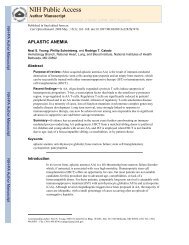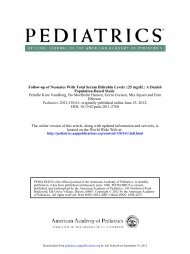Slipped Capital Femoral Epiphysis: Diagnosis and Management
Slipped Capital Femoral Epiphysis: Diagnosis and Management
Slipped Capital Femoral Epiphysis: Diagnosis and Management
Create successful ePaper yourself
Turn your PDF publications into a flip-book with our unique Google optimized e-Paper software.
ILLUSTRATION BY dAvId kLemm<br />
Normal SCFE<br />
12°<br />
b<br />
c<br />
Prophylactic treatment of the contralateral hip in<br />
patients with SCFE is controversial, but it is not recommended<br />
in most patients. Prophylactic pinning may be<br />
indicated in patients at high risk of subsequent slips, such<br />
as patients with obesity or an endocrine disorder, or those<br />
who have a low likelihood of follow-up. 11,15,30<br />
STABLE SCFE<br />
a<br />
Figure 6. Southwick method for determining slipped capital<br />
femoral epiphysis (SCFe) severity using a frog-leg lateral<br />
radiograph. The first line (a) is drawn from the anterior to<br />
the posterior epiphyseal edges. Next, a line (b) is drawn<br />
perpendicular to the first line. A third line (c) is drawn down<br />
the middle of the femoral diaphysis. The angle formed by<br />
lines b <strong>and</strong> c is the lateral epiphyseal-shaft angle (LeSA).<br />
The actual slip angle is the difference between the LeSA of<br />
the SCFe hip <strong>and</strong> that of the uninvolved hip.<br />
The st<strong>and</strong>ard treatment of stable SCFE is in situ fixation<br />
with a single screw 1,4,9,31 (Figure 7). Case series <strong>and</strong> animal<br />
model studies have shown this to be a simple technique<br />
with low rates of recurrence <strong>and</strong> complications. 4,9,31 After<br />
SORT: KEY RECOMMENDATIONS FOR PRACTICE<br />
Clinical recommendation<br />
Family physicians should consider SCFe when<br />
a child presents with limping <strong>and</strong> groin, hip,<br />
thigh, or knee pain.<br />
Physical examination of patients with SCFe<br />
usually shows decreased internal rotation of<br />
the hip <strong>and</strong> obligatory external rotation.<br />
Radiography to rule out SCFe should include<br />
anteroposterior <strong>and</strong> lateral views of the hips<br />
(frog-leg lateral views for stable SCFe; crosstable<br />
lateral views for unstable SCFe).<br />
The st<strong>and</strong>ard treatment of stable SCFe is in<br />
situ fixation with a single screw.<br />
SCFE = slipped capital femoral epiphysis.<br />
a<br />
c<br />
b<br />
40°<br />
Evidence<br />
rating References<br />
C 1, 3, 6-8<br />
C 1, 4, 8<br />
C 1, 9<br />
C 1, 4, 9, 31<br />
A = consistent, good-quality patient-oriented evidence; B = inconsistent or limitedquality<br />
patient-oriented evidence; C = consensus, disease-oriented evidence, usual<br />
practice, expert opinion, or case series. For information about the SORT evidence<br />
rating system, go to http://www.aafp.org/afpsort.xml.<br />
<strong>Slipped</strong> <strong>Capital</strong> <strong>Femoral</strong> <strong>Epiphysis</strong><br />
Figure 7. Anteroposterior radiography of bilateral stable<br />
slipped capital femoral epiphysis treated with in situ fixation<br />
with a single screw.<br />
closure of the growth plate, progression of athletic activities<br />
may be allowed, including running <strong>and</strong>, eventually,<br />
participating in contact sports. 1 Most patients with mild<br />
to moderate SCFE who are treated with in situ fixation<br />
have good to excellent long-term outcomes. 11<br />
UNSTABLE SCFE<br />
Unstable SCFE is a much more severe injury than stable<br />
SCFE. The rate of osteonecrosis is as high as 20 to<br />
50 percent in patients with the unstable form. 9,32 Treatment<br />
goals are similar to those of stable SCFE with in<br />
situ fixation, but there is controversy as to the specifics<br />
of treatment, including timing of surgery,<br />
value of reduction, <strong>and</strong> whether traction<br />
should be used. 1,31<br />
Complications<br />
AVASCULAR NECROSIS<br />
Avascular necrosis occurs in up to 60 percent<br />
of patients with unstable SCFE. 31 It<br />
is a serious complication associated with<br />
severe displacement <strong>and</strong> fixation with more<br />
than one screw. 8,29 Avascular necrosis often<br />
leads to advanced <strong>and</strong> early degenerative<br />
osteoarthritis. 33<br />
CHONDROLYSIS<br />
Chondrolysis is the acute loss of articular<br />
cartilage, which causes joint stiffness <strong>and</strong><br />
pain. 9 It is usually reported as a complication<br />
of surgical treatment of SCFE, but it<br />
can occur with the use of a hip spica cast<br />
<strong>and</strong> in untreated advanced SCFE. With the<br />
improvement of surgical techniques, the<br />
August 1, 2010 ◆ Volume 82, Number 3 www.aafp.org/afp American Family Physician 261





